काजू के तने और जड़ छेदक का एकीकृत कीट प्रबंधन
Stem and root borers, Neoplocaederus spp, Batocera rufomaculata (Cerambycidae: Coleoptera) are the major insect pests of cashew which is capable of killing the tree outrightly. There are three main species of stem borers were found to infest on cashew.
The species Neoplocaederus ferrugineus, and N. obesus are recorded as primary pests while Batocera rufomaculata recorded as a secondary pest of cashew. In India, the percentage of infestation and extent of damage various across the regions.
On an average, these borers kill about 5-10% of cashew yielding trees every year. In association with cashew stem and root borer, other secondary wood borers viz., Coptops aedificator, Aeolesthes holosericea, Glenea multiguttata, Euplatypus parallelus, and Belionota prasina were found aggravate the infestation.
Symptoms of damage
- Presence of small bore holes at the collar region.
- Extrusion of frass (like coarse dust powder) through the holes at the collar region.
- Oozing or exudation of gum from the damaged portion at the base of cashew tree trunk.
- Grubs bore into the living tissue of bark and feed on the sub-epidermal and vascular tissues.
- Extensive tunneling in the stem and root region and the tissues are tunnelled in irregular fashion.
- As a result of damage the supply of water and nutrients is arrested by which the leaves turn yellow and are shed, drying of twigs and finally leads to the death of the tree.
- Affected trees also tilt on one side due to loss of anchorage.
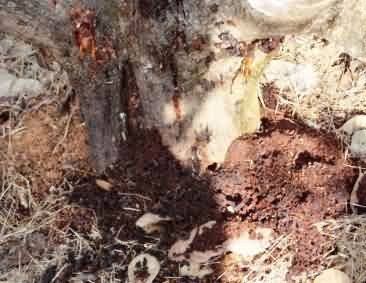
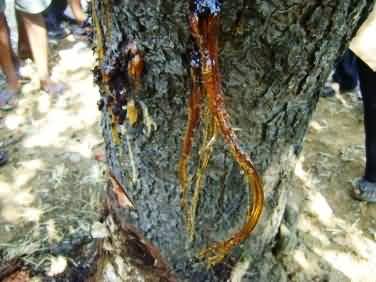 Extrusion of frass Gummosis
Extrusion of frass Gummosis
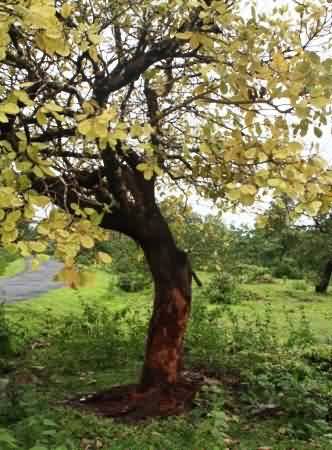
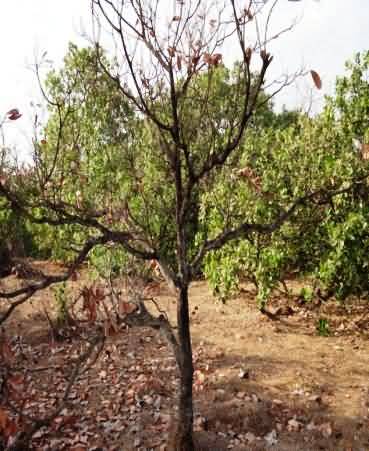 Yellowing of tree Drying of tree
Yellowing of tree Drying of tree
Identification and biology
- The adults of ferrugineus are chestnut red colored, longicorn beetle while adults of N. obesus are dull grey brown coloured longicorn beetle.
- rufomaculata adults are greyish in colour and pronotum having two kidney-shaped orange yellow spots.
- The eggs are deposited into the live tissues in crevices of loose bark in the trunk and exposed roots.
- The eggs are creamy white in colour, oval in shape and look like rice grains. The egg incubation period was 4-8 days.
- The grubs of Neoplocaederus spp are cream in colour having prognathus mouthparts with strong mandibles and passed through five instars. It has a pro-thoracic shield with two crescent shaped markings with three pro thoracic legs.
- The grub of rufomaculata also cream in colour and apodous.
- The grubs feed voraciously for a period of 4 to 8 months inside the tree trunk.
- Borer infested cashew trees die within a period 2-3 years depending upon the pest population.
- The tunnels made by Neoplocaederus spp are broad and irregular, deepest in the middle and shallow at the sides and fully packed with fibrous tissues and frass.
- The tunnels are extensive, irregular and deep, packed with coarse fibres and scraps of wood and bark by rufomaculata
- Grown up grubs enter into the heartwood region forms a calcareous cocoon. Pupal period last for 60-90 days.
- It complete the life cycle in one year.
- The adults are typically nocturnal (more active during night) in habit.
- The males have antennae more than the body length, whereas, in case of females it is smaller than body length.
- Throughout the year the pest incidence was recorded however peak incidence was noticed during the months of December – May in different cashew growing regions of India
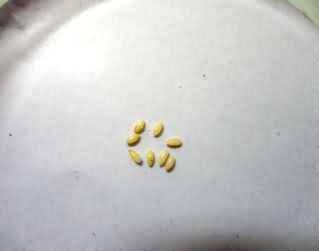
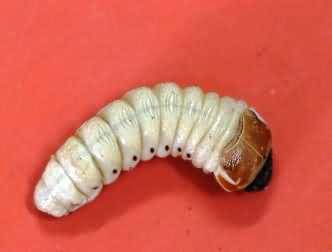 Eggs of Cashew Grub of cashew
Eggs of Cashew Grub of cashew
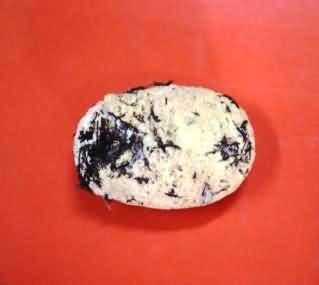
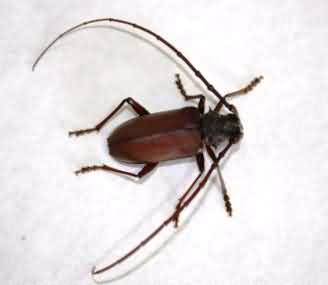 Cocoon of cashew borer Neoplocaederus ferrugineus
Cocoon of cashew borer Neoplocaederus ferrugineus
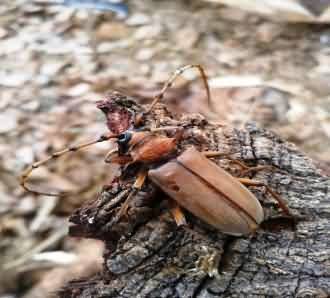
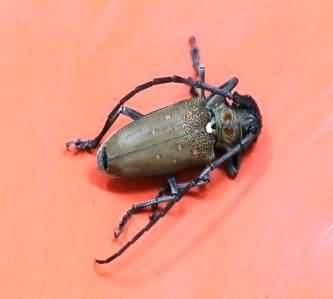 Neoplocaederus obesus Batocera rufomaculata
Neoplocaederus obesus Batocera rufomaculata
Alternate host plants
Mango (Mangifera indica), Moringa (Moringa oleifera), Fig (Ficus carica), Guava (Psidium guajava), Chironji (Buchanania lanzan, B. latifolia), Anjan (Hardwickia binate), Eucalyptus (Eucalyptus spp), Mulberry (Morus alba), Jackfruit (Artocarpus heterophyllus), Silk cotton (Bombax malabaricum) Pomegranate (Punica granatum), Apple (Malus domestica) Walnut (Juglans regia) Sapota (Manilkara zapota) and Rubber (Hevea brasiliensis).
IPM of stem and root borers in Cashew
Prophylactic management
- Maintenance of field sanitation by ploughing the interspaces in cashew plantations without damaging the roots.
- Avoid injuring the plants by sickle and other garden tools, which otherwise will attract the adult for egg laying.
- The phytosanitary measure includes removal of alternate host plants in and around the cashew plantations and weeds.
- Closer examination of trunk portion at monthly interval during April-May and October-November for eggs and grubs of stem borers.
- Periodical monitoring of trees having any damage symptoms like gummosis and frass material near the base of tree trunk.
- Remove dead trees and trees beyond recovery at least once in 6 months may reduce the spread of stem and root borer infestation.
- Mechanical removal of the immature stages (grubs) of the pest during initial stages of infestation.
- Insert the clutch cable into the bore holes to mechanically kill the grubs.
- Brushing the basal trunk region up to 2m height with a hard nylon brush to dislodge the eggs present in it.
- Prophylactic treatment by swabbing neem seed kernel extract 25% or swabbing the trunk region up to one meter height from the ground level with coal tar and kerosene (1:2) may be given twice a year during March-April and November-December to prevent the egg laying by adult beetles.
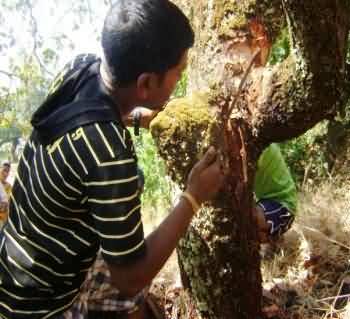
 Removal of grubs in cashew Mechanical control of grubs
Removal of grubs in cashew Mechanical control of grubs
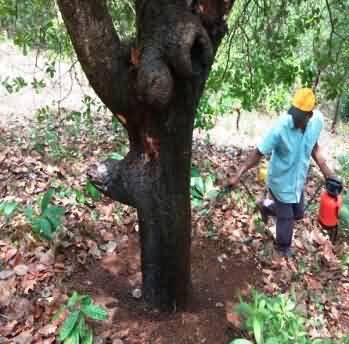
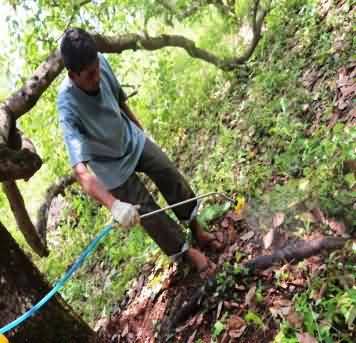 Drenching the collar region Drenching the exposed roots
Drenching the collar region Drenching the exposed roots
Curative management
- Treat the infested trees of the trunk region up to one meter height from the ground level and on exposed roots with Fipronil @ 2 ml in one litre of water
- Application of Imidacloprid @ 2 ml in one litre of water on collar region up to 1m height and on exposed roots.
- If fresh infestation occurs repeat the treatment after 30-45 days.
- Entomopathogenic fungus Metarhizium anisopliae and Beauveria bassiana known to cause mycosis to grubs of CSRB. Spawn may be mixed with organic matter and neem cake and applied to the bore holes and swabbed on the tree trunk. Entomopathogenic nematodes belonging to Steinernema and Heterorhabditis are found to be effective in managing stem and root borer under laboratory conditions.
Authors:
Dr. Maruthadurai.R
ICAR-Central Coastal Agricultural Research Institute, Ela, Old Goa, Goa
Email:
